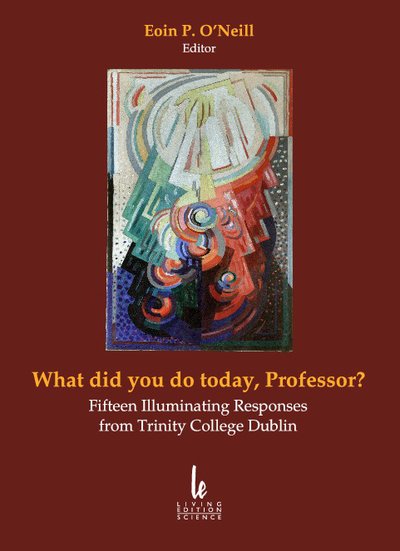What did you do today, Professor?
Fifteen Illuminating Responses from Trinity College Dublin
ISBN 978-3-901585-11-1 (softcover; English)
first edition, September 2008; 256 pages; 53 Fig. (2 illustrations in color, 40 illustrations in black/white, 11 tables); 235×170 mm (H×W); 710 g;
€ 20.00 (recommended retail price, incl. 10% VAT)
What, indeed, is the use of the abstractions of mathematics, such as ‘multiplying the north-east by the south-west’ ? But following development of Hamilton’s mathematical tools in Dublin, and other abstractions and theorems of great mathematicians, and the arrival of computers, the work of scientists became easier, and the subjects it became possible to study became more complex, and more interrelated to the lives we lead.
Classical literary questions such as that of Captain’s Boyle, ‘what is the stars?’ , from the very Dublin play Juno and the Paycock (Sean O’Casey) became for Hamilton’s heirs ‘how can we know what is happening out there among the stars?’ Other scientists tackled problems such as “What is risky about the food we eat? How do we track the drugs problem? How do we use measurements to estimate the variable natural energy supplies of wind and rain? Who do scientists work with? What are the problems of fast economic growth? How can we design synthetic replacements for our body’s joints? How do we get drug molecules to the organs that need them? How does a food scientist start his career? What’s it like to work in the largest scientific teams peering at the smallest fragments of smashed atoms? How will computers help us to visualise dynamic landscapes and town vistas, without actually building them? Where did Irish people record their history for a thousand years using careful error correction to maintain their chronologies? What feeds our interest in science? What tools will society need to cope with modern life? How do we make the connections between understanding nature and implementing social and economic progress? Where do scientists carry out their work? How do objects pack together in an organised fashion? What is the difference between noise and music, and how does understanding it help to design engines for planes? Do scientists understand and contribute to the Arts?”
The most difficult models of mathematics often feed the research of some of the scientists who described their work over twenty years to Eoin O’Neill, the Director of Innovation Services (latterly Director of Entrepreneurship) at Trinity College Dublin. In this book he has persuaded them to write in personal terms about their work and how they became absorbed in the quest for new knowledge.
(by Eoin P. O’Neill, TCD/TTEC, September 2008)
The Authors (in alphabetic order):
The below list constitutes the present positions of the scientists who wrote this book as of August 2008. They have between them held many other offices in Trinity College Dublin in the last quarter-century and have served, in addition to their research careers as scientists, as officers in a variety of international scientific organizations.
John Boland,
Director of CRANN (the Centre for Research on Adaptive Nanostructures and Nanodevices) and Professor of Chemistry, Trinity College Dublin;
John Corish,
Professor of Physical Chemistry, School of Chemistry, Trinity College Dublin;
Luke Drury,
Senior Professor at DIAS (the Dublin Institute for Advanced Studies), Director of the School of Cosmic Physics and the Andrews Professor of Astronomy, Trinity College Dublin;
John Fitzpatrick,
Professor of Mechanical Engineering, School of Engineering, Trinity College Dublin;
Michael Gibney,
Professor of Food and Health, School of Agriculture, Food Science and Veterinary Medicine, University College Dublin;
John Haslett,
Professor of Statistics, School of Computer Science and Statistics, Trinity College Dublin;
Alan Kelly,
Senior Lecturer in Biostatistics, Department of Community Health, School of Medicine, Trinity College Dublin;
Daniel Mc Carthy,
(retired) Senior Lecturer, School of Computer Science and Statistics, Trinity College Dublin;
Ignatius McGovern,
Professor, School of Physics, Trinity College Dublin;
Eoin P. O’Neill,
Director of Entrepreneurship Programme, Research and Innovation, Trinity College Dublin;
Carol O’Sullivan,
Dean of Graduate Studies, Professor in the School of Computer Science and Statistics, Trinity College Dublin;
Patrick Prendergast,
Chief Academic Officer, Vice-Provost, Professor of Biomechanics, School of Engineering, Trinity College Dublin;
Sinead Ryan,
Senior Lecturer, School of Mathematical Science, Trinity College Dublin;
Frances Ruane,
Director of ESRI (the Economic and Social Research Institute), Visiting Professor of Economics, Trinity College Dublin;
Denis Weaire,
emeritus Professor of Physics, Trinity College Dublin.
The Editor:
Eoin P. O’Neill, Director of Entrepreneurship, Research and Innovation, Trinity College Dublin

